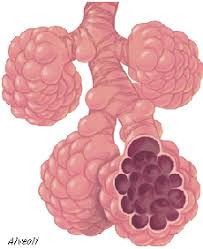Question #5140c
1 Answer
By remaining small and in bunches, similar to a bunch of grapes, alveoli maximize surface area, while maintaining a compact volume for efficient diffusion.
Explanation:
Alveoli are little sacs in your lungs that maximize surface area while maintaining a compact volume. The surface area of the alveoli in an average human's lungs is 70 SQUARE METERS (about 753 square feet), almost the size of a living room floor in a modest home. Let that sink in. Enough surface area to cover your living room fits inside your chest and lungs.
How?

Look at how, in the above graph, small cubes have a smaller surface area and smaller volume, but they have a larger surface area-to-volume ratio. Similarily, the folds in your alveoli make it so that such a large surface area can fit in your lungs. This concept occurs a lot in anatomy. The folds in your intestines allow them to fit in your stomach, but unraveled (don't try this at home :D ) they can stretch out quite far.

See how the alveoli look like a bunch of grapes? Is it easier to visualize how unraveling the alveoli will cover a larger surface area?
Why does this matter?
At the cellular level, diffusion transfers oxygen to your cells. When you inhale, oxygen coats the surface of your alveoli. The oxygen diffuses through the surface area, so more surface area means more efficient diffusion.
Imagine you have a small straw and a big straw. If you try sucking your drink through the smaller straw, it will take longer for you to finish, but a bigger straw means that you will drink more every sip. Similarily, more surface area allows oxygen to diffuse quicker.
Summary
The folds in the alveoli, as well as their small size, maximize surface area-to-volume area. Please ask for clarification in the comments if you don't understand anything.

